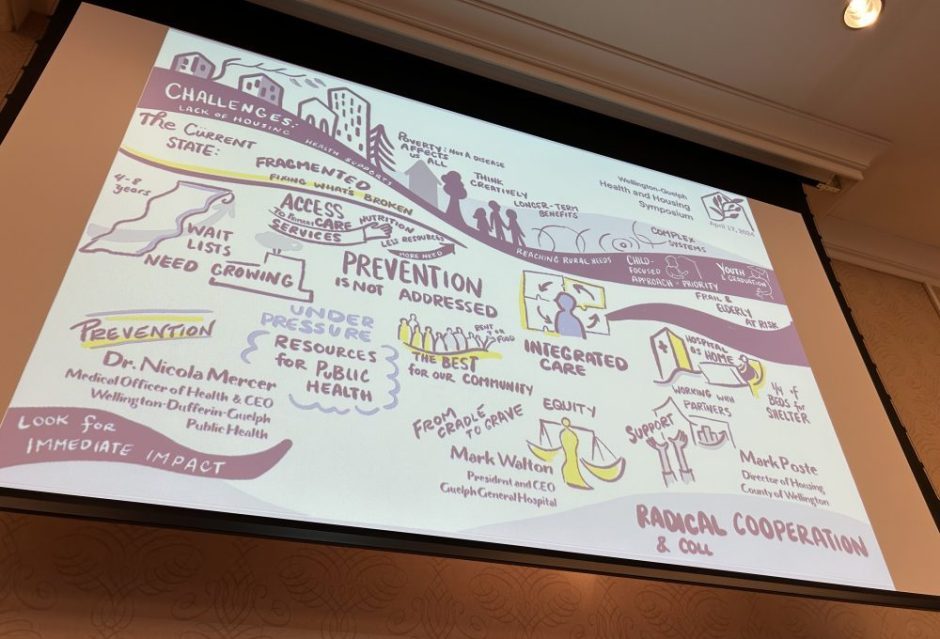“We either succeed together or we fail together,”Luisa Artuso said to kick off day #3 of the combined Guelph and Wellington County Health and Housing Symposium. Two days were held at the end of January with an invite-only crowd of local service providers, government staff and election officials, but this third day was open for the media to observe, and while a lot of ground was covered, this remains, if anything, only the beginning.
Since the January symposium, a number of actions have been taken. County staff and consultants have been engaged in the creation of a lived experience working group and an Indigenous working group, for which recruiting will begin shortly. There’s also a Health & Housing Community Action Plan Table that’s been created and they already met on April 5. Guelph Councillor Rodrigo Goller is one of the members of that table, and Social Services Committee Chair Dave Anderson is on it too.
To understand the scope the work ahead, Artuso recapped what came out of the January sessions in terms of key objectives including the integration of health and housings services, increased health services from primary to mental health care, and increased housing services across the spectrum. Along with that, there’s a big list of additional needs including more detox beds, more mental health support for youth and kids, ongoing communication about the waitlist for social housing, leveraging vacant municipal lands, more public education, and the provision of basic needs like toiletries for people living unhoused.
The morning’s speakers represented a wide variety of point of views on the issue, from people with lived experience to local health and housing officials, to academics, and other municipal officials innovating in their own jurisdiction.
Jason Schwartzentruber, the custodian at HOPE House, described his journey from housed to homeless and back again and how it wasn’t through any fault of his own. He told a story about renting a room from someone who tried to evict him right before Christmas and having no where to turn for help because the aid agencies were shutdown for the holidays. He was concerned for his own safety after his roommate threatened him with a machete.
“That’s how some people are pushed back into the system, that’s why they resort to substances because prolonged stress will drive a person crazy,” Schwartzentruber said. “That’s why I’m a firm advocate for an abundance of deeply affordable housing because if I just had a bunk somewhere, just enough space to keep a couple of personal things and a postbox it would have made a world of a difference because I would have felt safe each and every time.”
Dr. Erin Dej, an associate professor of criminology from Wilfred Laurier University, is an advocate for ending homeless by making sure that it never happens in the first place. She defines homelessness as a situation where someone is without stable, permanent and appropriate housing, meaning people living rough and people in temporary accommodations like hotels or hospital or even jail, plus people for whom a risk of homelessness is imminent like if a house is unsafe or unhealthy. Where her definition is different from most, Dej said, is the inclusion of hidden homelessness.
“Hidden homelessness are people who aren’t accessing shelters and are hardly touching the system, so we have a really hard time finding them and being able to count them,” Dej said. “What’s challenging is that our policies and our practices are based on what we know, and if we don’t know it, and if we don’t see it, we’re less likely to to invest in it.”
Dej said that this is especially the case for marginalized people like the queer community, women, Indigenous people and youth because they typically don’t access shelters out of safety concerns. Dej also noted the three causes of homelessness, which may not be what you think. There’s the emergency or change resulting from something personal, and there are systemic issues, meaning gaps in the system, but the big one is the structural causes, the lack of policy and investment to deal with the problem as it exists right now.
“If you ask somebody who’s experiencing homelessness how they became homeless, most of them will talk about their job loss, divorce, and things like that. They’re probably not gonna say, ‘Well Erin, I’m homeless because in 1993 the federal government disinvested in social housing,’ right?” she said. “If we focus only on those individual factors, we’re missing a huge chunk of these root causes of homelessness.”
And if you feel like the problem is worse today, you’re right, and that’s systemic too.
“When the homelessness explosion happened in the 1990s, it happened relatively quickly and the sector was caught off guard. They only had what was available to them, and these tools had been designed and built to support a much smaller number of people, a less diverse group of people and people with fewer needs generally seen today,” Dej explained. “This was, and continues to be, our primarily emergency response; the system that was there before the 90s was about responding to temporary emergencies, predominantly older men who were looking for work.”
Fragmentation was a theme in the panel discussion with Medical Officer of Health Dr. Nicola Mercer, Guelph General Hospital CEO Mark Walton, and Wellington County Director of Housing Mark Poste. All three noted that silos were an issue, the way that regulations seem to force agencies to “stay in their lane” when there’s opportunity to be innovative and work outside the box.
“We have the opportunity to step in and create our own rules,” Walton said. “Just recently we talked about radical collaboration, and I think that’s exactly what is required at this point in time. The implications are broad or complex, and I think we have an opportunity to cut through the bullshit and get some good stuff done”
“We have to stop thinking of poverty like a disease, it’s a series of unfortunate events that often begin long before that person was of age to make a decision,” Mercer said. “There are often family, systemic, and structural reasons people are raised in poverty. I come from a privileged background, I recognize that, I acknowledge that, and some of you may as well. We need to see poverty as something that we have the levers and tools to solve, and we can make decisions that actually improve lives.”
“It is really reflective of failures across many, many different systems that are meant to support individuals in those moments of crisis and they’re not hitting our emergency shelter systems unless they’ve fallen through the cracks of all these other different places,” Poste added. “I think it’s it’s not just a health and housing thing, it’s really up to all the services to be a part of the solution.”
Some municipalities have already begun creating their own solutions. Kelly Goz, manager of homelessness special projects at the City of Windsor, discussed the creation of the H4, the Homelessness and Housing Help Hub. It was started in the midst of the COVID-19 pandemic as a way to compensate for the lost shelter space due to social distancing precautions. That’s when they saw the solution: Waterworld.
“We had an underutilized city facility at Waterworld that was literally 20 feet from our office,” Goz said. “We worked with our recreation staff to convert it. There was controlled access with a security guard with a COVID screening, we had isolation areas, a front reception desk, and a gymnasium that was more of a passive space with tables situated six feet apart. Since that time, we’ve continued to evolve and change based on what people were telling us that they needed.”
The things that they needed end up being not just a place to stay in the day, or a bite to eat, but easy access to services, including their legal services. Goz explained that one of the evolutions at H4 was the inclusion of probation and parole officials from the provincial court to make it easier for people to follow up on their release conditions, a move that Goz says has prevented 133 people from ending up back in the judicial system. She added that the pandemic ended up offering a rare opportunity to engage in some of that radical collaboration Walton talked about
“A lot of the work that we’re talking about today came out of COVID, it presented a lot of opportunity that allowed us to disrupt systems and think creatively, because we were forced to come in and do something different; we can no longer continue to accept the status quo,” Goz explained.
Another swipe at the status quo is the Nurse-Police Team, a combined project of the Windsor Regional Hospital and the Windsor Police Service in order to respond to the growing number of well-being calls being received by the police, and the growing number of acute cases being received in the emergency department that might more easily be resolved if those patients got care sooner.
“From a small pilot from May to September 2023, over 477 patients were seen and over 44 per cent were diverted from the emergency department,” Goz explained. “The NPT team was able to respond in real-time based on giving people what they were asking for, and they also started to assist the workers in the health sector understand some of the challenges related to health care access and health inequities based on this population. It changes the conversation when you start to see and believe what’s actually happening.”
After the lunch break, the room broke up into small tables to discuss each of the 12 elements that were determined in January to make up a health and housing plan. Those elements include housing options, emergency responses, Indigenous solutions, public education, policy and funding advocacy, prevention, and mapping and data collection. Participants were invited to take turns are three different tables through the afternoon.
At the end of the meeting, Artuso returned to the stage and thanked the speakers for their input today, and thanked County staff for organizing the event. The information from all three sessions will be collated and presented at a later date. Artuso reminded everyone that this was the beginning of the process not the end.
You can find the tweet thread from the coverage of the symposium below:

